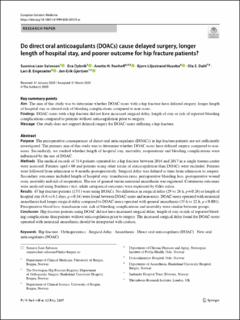| dc.contributor.author | Leer-Salvesen, Sunniva | |
| dc.contributor.author | Dybvik, Eva Hansen | |
| dc.contributor.author | Ranhoff, Anette Hylen | |
| dc.contributor.author | Husebø, Bjørn Liljestrand | |
| dc.contributor.author | Dahl, Ola Einar | |
| dc.contributor.author | Engesæter, Lars B. | |
| dc.contributor.author | Gjertsen, Jan-Erik | |
| dc.date.accessioned | 2021-03-25T10:59:28Z | |
| dc.date.available | 2021-03-25T10:59:28Z | |
| dc.date.created | 2020-11-07T15:56:52Z | |
| dc.date.issued | 2020 | |
| dc.Published | European Geriatric Medicine. 2020, 11 (4), 563-569. | |
| dc.identifier.issn | 1878-7649 | |
| dc.identifier.uri | https://hdl.handle.net/11250/2735499 | |
| dc.description.abstract | Purpose
The perioperative consequences of direct oral anticoagulants (DOACs) in hip fracture patients are not sufficiently investigated. The primary aim of this study was to determine whether DOAC-users have delayed surgery compared to non-users. Secondarily, we studied whether length of hospital stay, mortality, reoperations and bleeding complications were influenced by the use of DOAC.
Methods
The medical records of 314 patients operated for a hip fracture between 2016 and 2017 in a single trauma center were assessed. Patients aged < 60 and patients using other forms of anticoagulation than DOACs were excluded. Patients were followed from admission to 6 months postoperatively. Surgical delay was defined as time from admission to surgery. Secondary outcomes included length of hospital stay, transfusion rates, perioperative bleeding loss, postoperative wound ooze, mortality and risk of reoperation. The use of general versus neuraxial anaesthesia was registered. Continuous outcomes were analysed using Students t test, while categorical outcomes were expressed by Odds ratios.
Results
47 hip fracture patients (15%) were using DOACs. No difference in surgical delay (29 vs 26 h, p = 0.26) or length of hospital stay (6.6 vs 6.1 days, p = 0.34) were found between DOAC-users and non-users. DOAC-users operated with neuraxial anaesthesia had longer surgical delay compared to DOAC-users operated with general anaesthesia (35 h vs 22 h, p < 0.001). Perioperative blood loss, transfusion rate, risk of bleeding complications and mortality were similar between groups.
Conclusion
Hip fracture patients using DOAC did not have increased surgical delay, length of stay or risk of reported bleeding complications than patients without anticoagulation prior to surgery. The increased surgical delay found for DOAC-users operated with neuraxial anaesthesia should be interpreted with caution. | en_US |
| dc.language.iso | eng | en_US |
| dc.publisher | Springer | en_US |
| dc.rights | Navngivelse 4.0 Internasjonal | * |
| dc.rights.uri | http://creativecommons.org/licenses/by/4.0/deed.no | * |
| dc.title | Do direct oral anticoagulants (DOACs) cause delayed surgery, longer length of hospital stay, and poorer outcome for hip fracture patients? | en_US |
| dc.type | Journal article | en_US |
| dc.type | Peer reviewed | en_US |
| dc.description.version | publishedVersion | en_US |
| dc.rights.holder | Copyright The Author(s) 2020 | en_US |
| cristin.ispublished | true | |
| cristin.fulltext | original | |
| cristin.qualitycode | 1 | |
| dc.identifier.doi | https://doi.org/10.1007/s41999-020-00319-w | |
| dc.identifier.cristin | 1845852 | |
| dc.source.journal | European Geriatric Medicine | en_US |
| dc.source.40 | 11 | |
| dc.source.14 | 4 | |
| dc.source.pagenumber | 563–569 | en_US |
| dc.identifier.citation | European Geriatric Medicine. 2020, 11, 563–569. | en_US |
| dc.source.volume | 11 | en_US |

